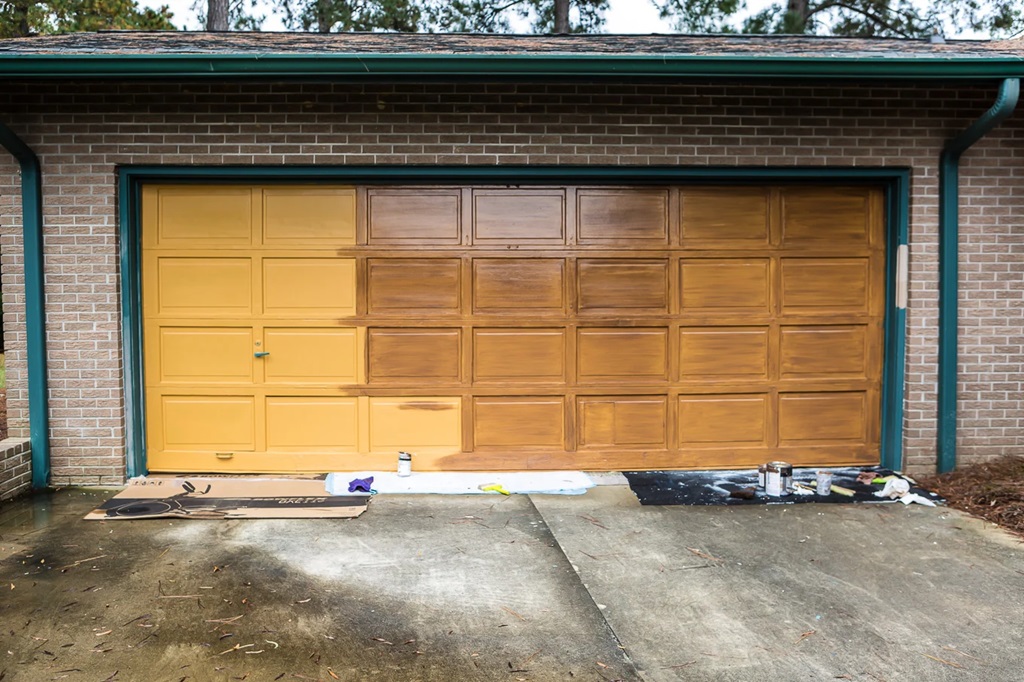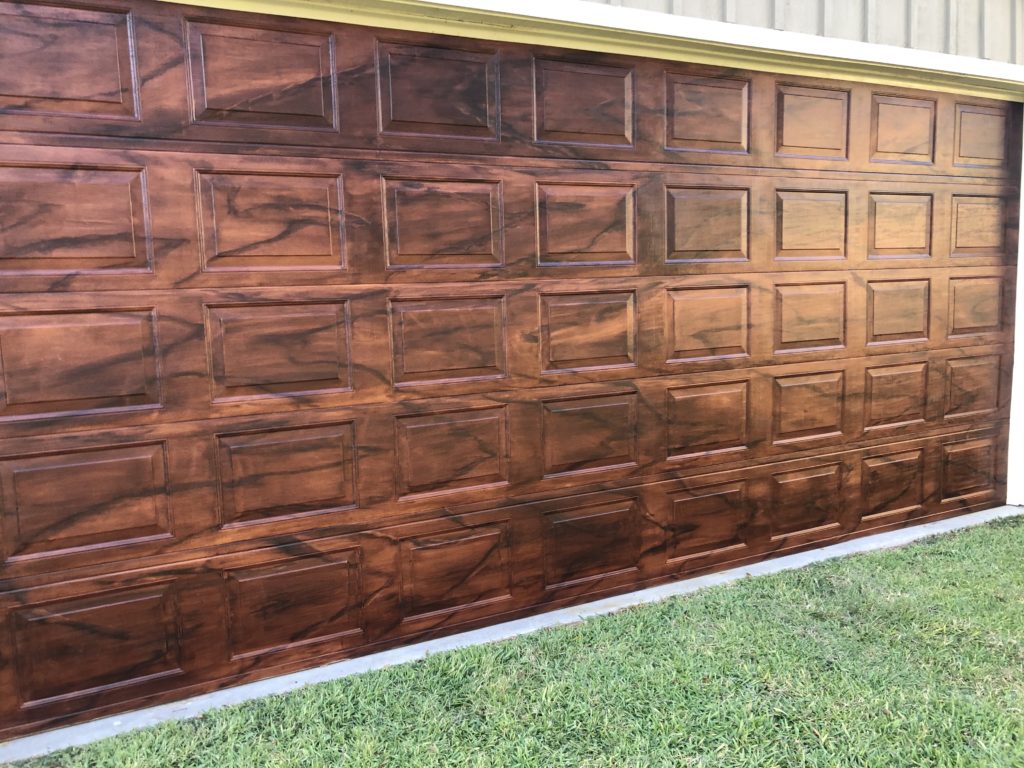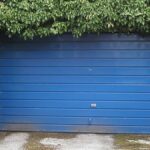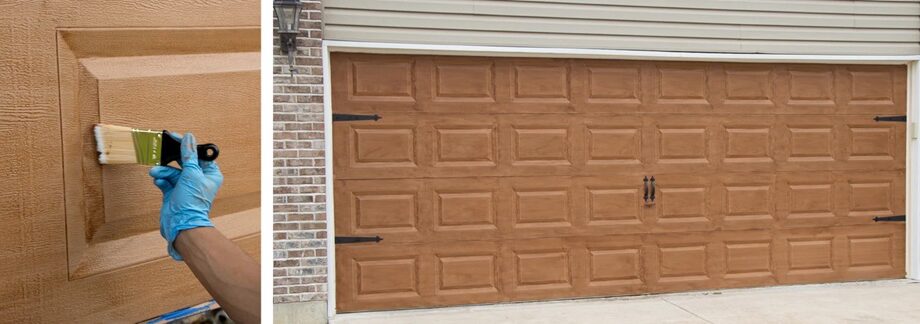Many homeowners with aluminum garage doors wish they had charming wood doors instead. While replacing the entire door is costly, you can quickly transform the look to paint an aluminum garage door—painting aluminum to appear like wood takes some preparation but delivers stunning results.
This comprehensive DIY guide covers everything you need to know to paint your aluminum garage door to resemble wood. I’ll walk through the process, from choosing paints to applying finish coats. You’ll also find tips for selecting the right wood look and maintaining the finish. By the end, your dated aluminum door will have the beautiful, natural wood look you desire.

Benefits of Painting Your Aluminum Garage Door
Painting offers an affordable way to change the look of your home. Here are some of the benefits of painting aluminum garage doors:
- Cost savings – A complete garage door replacement can cost over $1000. Painting provides the new look you want for a fraction of the price. Expect to spend $100-$300 on supplies for a DIY paint job.
- Curb appeal – Wood garage doors add warmth and craftsman-style beauty to a home’s exterior. Your freshly painted door makes a beautiful first impression.
- Increased home value – Improving your home’s curb appeal and style pays off when it’s time to sell. Painting the dated aluminum door makes your house more desirable.
- Customization – You can choose your ideal wood species and tone. Match your home’s color scheme or complement the landscaping.
- Protection – Paint renews and protects aging aluminum from further sun damage and oxidation.
- Self-expression – DIY painting allows you to flex your creative muscles and enjoy a fun weekend project.
Choosing the Right Wood Look
Now comes the fun part – selecting your dream wood door style! There are many wood species and finishes to consider:
Wood Species
Consider the overall look you want, and choose a wood species that aligns. Here are some popular options:
- Knotty pine – Has a casual, rustic vibe with pronounced wood grain and knots. It pairs nicely with cabins, cottages, and ranch houses.
- Alder – Has a mellow tan color with minimal grain lines. Gives a refined, welcoming look.
- Douglas fir – Looks similar to pine but slightly redder. The bold grain provides a rugged, outdoorsy feel.
- Oak – Has a deep brown hue and striking grain pattern. Oozes classic beauty and elegance.
- Teak – Features a tan/gold color with subtle vertical grain. Gives a luxurious, nautical vibe.
Paint Colors
Consider both the shade and undertones. Light, warm-toned paints make the aluminum appear authentic. Some suitable hues include:
- Honey brown
- Cinnamon
- Butterscotch
- Khaki
- Olive green
- Sage green
- Soft white/cream
Look at photos of natural wood doors to choose a color you love. Remember the door’s environment – a cool shade prevents a hot garage from heating up in summer.
Paint Sheen
The right sheen plays a significant role in achieving a realistic wood look. Here are the best options:
- Flat – The low sheen helps hide surface imperfections. It is ideal for knotty pine or weathered wood.
- Satin – Provides subtle sheen with some surface reflection. Looks like stained wood.
- Semi-gloss – The medium gloss mimics varnished or lacquered wood. Add a clear coat for extra realism.
Weathered or Distressed
For an authentic, aged wood look, consider weathered or distressed techniques:
- Weathered – Use paint mixed with glaze for subtle variation in tone. It resembles sun-faded wood.
- Distressed – After painting, artificially crack and peel paint to mimic worn wood. Leave some aluminum exposed.
How to Prepare the Garage Door Surface
Proper prep ensures the paint adheres well and lasts. Follow these steps:
Clean the Surface
Use TSP substitute cleaner and a firm scrub brush to remove dirt, oil, chalky paint, and oxidation from the aluminum. Rinse well and let dry thoroughly.
Scuff the Surface
Lightly sand with 150-grit sandpaper to rough up the slick aluminum and help the paint grip.
Spot Prime
Use a quality metal primer like Rust oleum to spot-prime any remaining shiny aluminum, bare metal spots, or rust.
Caulk Seams
Caulk around all exterior seams and rivets with a paintable exterior caulk. This prevents moisture from getting underneath the paint.
Mask Off Areas
Use painter’s tape and plastic to mask off windows, trim, and hardware completely. Protect nearby siding or brickwork as well.
Now, the aluminum garage door is prepped and ready to paint!
Picking the Right Paints
Quality paints mean better results and longer-lasting curb appeal. Consider these factors:
Primer
Primer bonds paint to the slick aluminum surface. Use a high-quality acrylic bonding primer like Zinsser Bulls Eye 1-2-3.
Color Coats
For aluminum, select an exterior acrylic latex paint. Avoid cheaper vinyl and oil-based paints that don’t flex well. Durability matters on a garage door!
Top Coat (Optional)
A clear satin or semi-gloss sealer adds extra protection and a more realistic wood look. Use an exterior-grade polyurethane or varnish.
Additional Products
- Paintable caulk – For filling cracks and holes
- Glazing liquid – For weathered paint techniques
- Grain filler – For creating wood grain texture
Buy quality brushes, rollers, and other essential supplies. Don’t skimp on the products for your project.

DIY Painting Your Aluminum Garage Door
Now, let’s go through the entire painting process from start to finish:
1. Apply Primer
Use a brush to prime all surfaces – inside, outside, and on all edges. Allow the Primer to dry thoroughly per the manufacturer’s directions.
2. Create Wood Grain Texture (Optional)
For a pronounced wood grain look, use grain filler before painting:
- Trowel on liquid filler, working in straight strokes to imprint grain lines. Let dry.
- Knock down high points with a rag before the paint dries completely.
- Prime over filler before applying color coats.
3. Paint Color Coats
Cut edges with a brush, then roll paint in sections, working from top to bottom. Use an extension pole and pad to reach high areas. Allow thorough drying between coats.
- Use 2-3 coats for full aluminum coverage and vivid color depth.
- Make the final coat slightly darker, or apply a glaze for extra dimension.
4. Weathered Finish (Optional)
- Mix paint with glazing liquid for a subtle, weathered look. Dry brush over edges and raised surfaces.
- Or use two tones. Undercoat with lighter base, then accent with darker topcoat. Wipe a darker color to let the base show through.
5. Distressed Finish (Optional)
- After the paint dries, rub spots with sandpaper or steel wool to expose aluminum underneath. Focus on edges and natural wear points.
- Use an awl or screwdriver handle to chip paint and imitate worn spots or cracks. Apply varying pressure.
- Soften distressed areas by dry brushing the base color over the top. Add wood putty in cracks for realism.
6. Apply Clear Top Coat
For a glossy, varnished wood look, apply 1-2 coats of clear polyurethane or varnish. Allow proper drying time between coats.
7. Remove Masking and Reinstall Hardware
Carefully remove all masking materials. Reinstall door handles, lights, etc. Admire your brand new “wood” door!
Maintaining the Finish
With proper care, your faux wood door will stay beautiful for years. Follow these maintenance tips:
- Allow paint to fully cure 1-2 weeks before washing. Hose gently to avoid damage.
- Touch up scratches immediately to prevent moisture from entering.
- Clean with mild soap and water. Avoid harsh cleaners.
- Reapply topcoat sealers every 1-2 years. Watch for fading or cracking paint.
- Repaint every 3-5 years as needed to refresh the wood-like appearance.
With some simple maintenance, your custom-painted creation will continue looking like a million bucks!
FAQs
1. Does the aluminum door require sanding or etching before painting?
Light scuff sanding with 150 grit sandpaper is recommended so the paint can grip the slick aluminum surface. Etching is not required, but priming is essential.
2. What kind of Primer should be used?
A quality acrylic bonding primer for metal like Zinsser Bulls Eye 1-2-3 is ideal. It bonds to the slick aluminum and provides a surface for the paint to stick to.
3. Can latex paint be used on an aluminum garage door?
Yes, exterior acrylic latex paints work very well. Avoid lower-quality vinyl or oil-based paints. Acrylic latex offers better adhesion and durability on aluminum garage doors.
4. How long does it take for the paint to cure fully?
The paint may feel dry to the touch in 1-2 days, but allow at least 1-2 weeks for a complete cure. This ensures the paint finish reaches optimal hardness and durability.
5. Does the inside of the garage door need to be painted, too?
For longest-lasting results, paint the inside surfaces as well. Use Primer and 1-2 color coats. This fully protects the aluminum from moisture and prevents oxidation-related swelling or bubbling of the paint.
Conclusion
Painting aluminum garage doors to look like wood is an easy, affordable way to transform the style of your home. You can achieve gorgeous, realistic results with proper preparation, quality paints, and attention to detail. Garage door dent repair tasks are straightforward and cost-effective, allowing you to avoid the expense of full replacement. Not only will you save money compared to replacement, but you’ll also enjoy a fun DIY paint aluminum garage door project and new curb appeal. Your custom-painted creation will become a focal point you adore coming home to daily.











